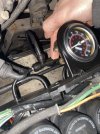8v_chris
Member
- Posts
- 63
- Location
- Northern Ireland
I’m sure this has been flogged to death and then some but I didn’t find a response to a similar question online and I’m pretty much just rambling out loud here but hopefully the huge knowledge base here will know. Can a leak on the EAS be detected using a UV type dye similar/the same as used on an AC system to nail down a leak? I’ve had a slow leak on my EAS for a wee while now and it needs addressed so as not to burn out my pump.
The situation - my EAS inflates as normal, works as normal (ignoring a recent pump failure prior to valve block rebuild), goes from empty tank to full tank in about 8-9 minutes or so with the door open etc, and crucially, the air bags do not lose any air at all overnight; no low corners indicating a bad bag and she will sit up nice and high for days on end with no problems. The tank however will have emptied itself to about 20 psi over say two days. This morning it was full at 130 psi and over 4 hours dropped to 90 psi. I’m monitoring this on my inline pressure gauge plumbed in on line 6 between the level block and the tank.
What I’ve tried - I found that about a few weeks ago my diaphragm valve in the valve block was leaking and air was moving back through valve block, through the air dryer and out into the air. This was found by the bubble mixture method. I’ve stripped the block down and did a full rebuild from X8R, using the Vaseline in the right places and it sealed it up nicely. I’ve been round and round the while system with more bubble mixture but haven’t found anything since despite this weep of air showing on my air pressure gauge. I also ran a temporary line between the gauge and the tank thinking maybe there was a leak in the line but it’s just the same. I’ve also capped off the tank from the rest of the system using a black plug just after the valve block and seeing the same effect - air leak leaking, so I don’t think it’s the tank and it’s plumbing, it’s somewhere in the valve block. Should also note that watching the gauge the leak is there whether the engine runs or not.
With no bubbles appearing anywhere I’m at a loss and don’t really want to pull the valve block apart again but not know where is “bad” nor do I want to chop up my EAS adding in manual valves etc. in my mind this opens more problems further down the road. So going back to my original question - in this scenario would UV dye in the EAS work? Thanks!
The situation - my EAS inflates as normal, works as normal (ignoring a recent pump failure prior to valve block rebuild), goes from empty tank to full tank in about 8-9 minutes or so with the door open etc, and crucially, the air bags do not lose any air at all overnight; no low corners indicating a bad bag and she will sit up nice and high for days on end with no problems. The tank however will have emptied itself to about 20 psi over say two days. This morning it was full at 130 psi and over 4 hours dropped to 90 psi. I’m monitoring this on my inline pressure gauge plumbed in on line 6 between the level block and the tank.
What I’ve tried - I found that about a few weeks ago my diaphragm valve in the valve block was leaking and air was moving back through valve block, through the air dryer and out into the air. This was found by the bubble mixture method. I’ve stripped the block down and did a full rebuild from X8R, using the Vaseline in the right places and it sealed it up nicely. I’ve been round and round the while system with more bubble mixture but haven’t found anything since despite this weep of air showing on my air pressure gauge. I also ran a temporary line between the gauge and the tank thinking maybe there was a leak in the line but it’s just the same. I’ve also capped off the tank from the rest of the system using a black plug just after the valve block and seeing the same effect - air leak leaking, so I don’t think it’s the tank and it’s plumbing, it’s somewhere in the valve block. Should also note that watching the gauge the leak is there whether the engine runs or not.
With no bubbles appearing anywhere I’m at a loss and don’t really want to pull the valve block apart again but not know where is “bad” nor do I want to chop up my EAS adding in manual valves etc. in my mind this opens more problems further down the road. So going back to my original question - in this scenario would UV dye in the EAS work? Thanks!

